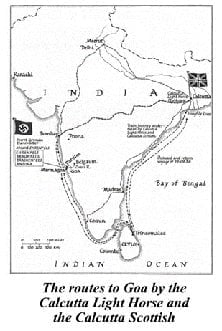
The Calcutta Light Horse and Operation Creek
If you think that the Home Guard, which we now know affectionately as Dad’s Army, were only found in England, then you need to learn about the extraordinary tale of Operation Creek by the Calcutta Light Horse in Goa in 1943.
This was no ordinary military engagement, it was part commando raid, part gentleman’s adventure, and part a daring gamble carried out by a group of men who never expected to see combat again.
The Calcutta Light Horse
The Calcutta Light Horse was first formed in 1872 as a cavalry regiment within the British Indian Army’s reserve. In their prime, they had once been a proud and dashing mounted unit, but as the decades rolled on and warfare changed, the regiment became something very different.
By the time of the Second World War in 1943, the Calcutta Light Horse had long since ceased to be an active combat force. Instead, it had turned into a rather exclusive drinking club for retired officers, civil servants, and businessmen living in Calcutta. Most of its members were middle-aged or older, past the years of military campaigning, and certainly not expecting to see themselves thrown into a covert mission behind enemy lines.
Yet, history has a habit of calling on the most unlikely people at the most unlikely times.
The Problem in Goa
Britain was fully engaged in the global struggle of the Second World War, and India, still part of the British Empire, was heavily involved in the war effort. But not every part of the Indian subcontinent was under British control. The small port of Goa, located on the west coast of India, belonged to Portugal, which had declared neutrality.
At first this caused little concern. Since 1939, three German merchant ships had taken refuge in the neutral harbour of Goa. Neutral ports often provided safe havens for merchant vessels that could not risk sailing home. The British initially assumed that these ships were simply waiting out the war and posed no real danger. After all, international law protected them so long as they did not act aggressively.
Then in 1942, suspicions began to grow. British merchant shipping leaving Bombay (now known as Mumbai) was suffering shocking losses from German U-boats lurking in the Arabian Sea. In the autumn of 1943 alone, forty-six merchant ships were attacked. This was no coincidence.
The Special Operations Executive (SOE), which had recently established an India Mission at Meerut, began to intercept radio signals. To their alarm, these signals appeared to originate not from the sea, but from inside Goa’s theoretically neutral harbour.
The Spy and the Signals
Investigations revealed that a German agent, Robert Koch, and his wife, Grete, were living comfortably in Goa.
In November 1942, SOE agents attempted to capture them, and although they managed to disrupt some of their activities, the real breakthrough came when intelligence confirmed that one of the German ships in the harbour, the Ehrenfels, was far from innocent. Far from being an idle merchant vessel, it was acting as a powerful radio transmitter, sending vital information about Allied shipping movements to German U-boats. Koch was helping coordinate the signals.
This intelligence was devastating. It meant that British losses at sea were being orchestrated not from faraway Europe, but from a neutral port just down the coast from Bombay.
Something had to be done, however there was a problem.
The Dilemma of Neutrality
The laws of war were very clear. Britain could not simply sail into a neutral harbour and attack the Ehrenfels. That would have been an open violation of Portuguese neutrality and could have drawn Portugal into the war against the Allies.
Diplomatically, it was impossible. Militarily, however, the British could not afford to let the Ehrenfels continue its deadly transmissions.
So, a typically British solution was needed. This is where the most possible unlikely heroes came into the picture: the Calcutta Light Horse.
The Call to Action
However, as the British armed forces could not officially conduct the raid, the SOE came up with a plan to use irregular volunteers. The Calcutta Light Horse, although more accustomed to whisky and polo than covert operations, were approached. They were quietly asked to recruit fourteen volunteers for a special operation. Now, it is worth noting that they were not young commandos or professional soldiers, no, they were old reservists, who were now bankers, solicitors, and merchants, many with families. They were sworn to secrecy and told they were embarking on an unofficial mission that might never be recognised, even if successful.
The Journey
The operation began with a long and dangerous journey. A small vessel, the Phoebe, was fitted out for the mission. Then a few of the volunteers sailed aboard her all the way around the southern tip of India, a voyage of more than 1,400 miles. The remainder took the train across the continent and joined the ship in secret. For weeks they prepared, were trained under SOE supervision in sabotage, demolition, and boarding tactics, skills few of them had ever expected to use again.
The Night of the Attack
By extraordinary luck, the raid coincided with the end of Carnival in the town of Vasco da Gama. Our heroes used their funds to throw a lavish party, inviting the German crews from the harbour’s ships. Most of the sailors were bored so gladly attended, leaving only skeleton crews on board. This drastically reduced the number of men guarding the Ehrenfels.
Then fate seemed to be with them as the lighthouse and harbour buoy were inexplicably dark that night. This allowed the Phoebe to slip silently into the harbour under cover of darkness.
The assault force boarded the Ehrenfels, killed its captain and several crew in a brief but fierce struggle, and seized the transmitter equipment. But the Germans acted quickly, the crew opened the ship’s sea valves, scuttling the vessel rather than allowing it to fall into British hands.
As flames rose and the Ehrenfels began to sink, the other crews on the other German ships, the Drachenfels, the Braunfels, and the Anfora panicked. Believing that they were next to be boarded and captured, their crews scuttled their own ships to prevent seizure.
In that single bold night, four German vessels were lost, while the Calcutta Light Horse returned to the Phoebe and made their escape without a single casualty.
The Aftermath
The results were immediate and dramatic.
Within days, the effectiveness of German U-boats in the Indian Ocean collapsed. Where forty-six ships had been attacked in the autumn of 1943, in the weeks following Operation Creek only one ship was lost, and just two the month after. The lifeline from India to Britain had been secured.
The captured German crews were picked up by the Portuguese authorities and held in internment camps until the war’s end. Local newspapers reported that the men had mutinied and destroyed their own ships. The true story was far too sensitive to be revealed.
As for the Calcutta Light Horse, they returned quietly to their peacetime lives. Because the operation was highly secret, none of the men could be officially recognised or decorated.
With the result that their efforts remained unknown.
The Legacy
Well, they didn’t, as it was in 1980 that the remarkable tale of Operation Creek was finally revealed to the public, yes, it was immortalised in the film The Sea Wolves, starring Gregory Peck, Roger Moore, and David Niven. At last, the middle-aged amateurs who had carried out one of the most daring and unlikely commando raids of the Second World War received some recognition.
So next time you think of Dad’s Army as a gentle comedy of blundering volunteers, remember the Calcutta Light Horse, a group of men who swapped their gin and tonics for hand grenades and pulled off an audacious raid that changed the course of the war in the Indian Ocean.
Isn’t history fun?
10 questions to discuss:
- Beyond Goa: While Goa is the focus, were there other potential targets considered for this operation, and why was Goa ultimately chosen?
- Calcutta Light Horse Selection: What specific criteria were used to select the 14 volunteers from the Calcutta Light Horse and Calcutta Scottish? Did their past experiences or skills play a role?
- Carnival Cover: How did the Carnival celebrations effectively mask the team’s true intentions and facilitate their infiltration of the harbor?
- Neutral Territory Concerns: Beyond simply avoiding open invasion, were there any specific risks or challenges associated with operating in a neutral port like Goa?
- Alternative Strategies: Were there other potential plans considered, such as sabotage or negotiation, before resorting to capturing and sinking the Ehrenfeld?
- Unexpected Challenges: Did the team encounter any unexpected obstacles or complications during their mission, and how did they adapt?
- Long-Term Impact: Beyond sinking the Ehrenfeld and disrupting U-boat activity, what were the wider strategic or political ramifications of Operation Creek?
- Recognition Debate: While the film “The Sea Wolves” brought attention to the team, do you think they deserve more official recognition for their contributions?
- Modern Relevance: Are there any contemporary parallels or lessons learned from Operation Creek that can be applied to covert operations or international relations today?
- Historical Accuracy: How does the blog compare to other accounts of Operation Creek, and are there any debates or controversies surrounding the historical accuracy of its portrayal?
These questions encourage deeper exploration of the planning, execution, and historical significance of Operation Creek, moving beyond the basic narrative to consider strategic choices, ethical concerns, and lasting impacts.
To learn more click on:

